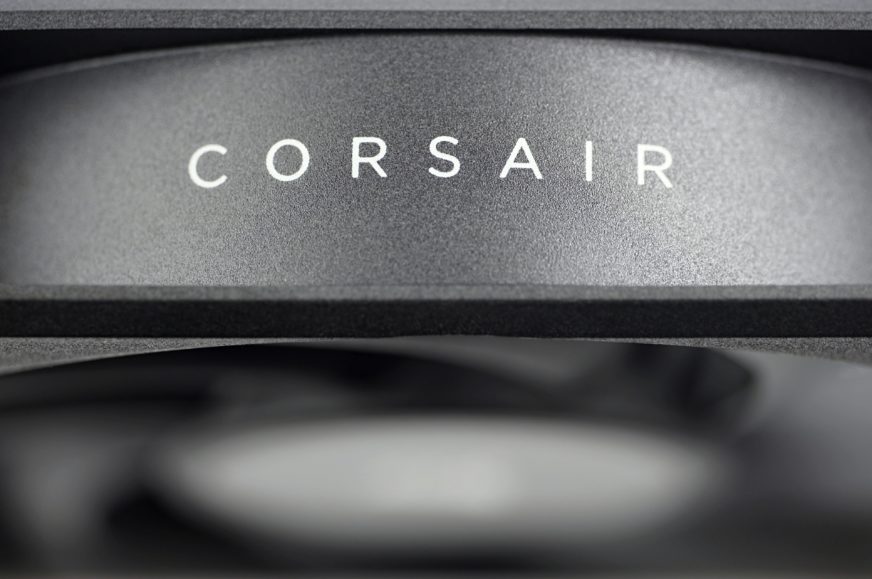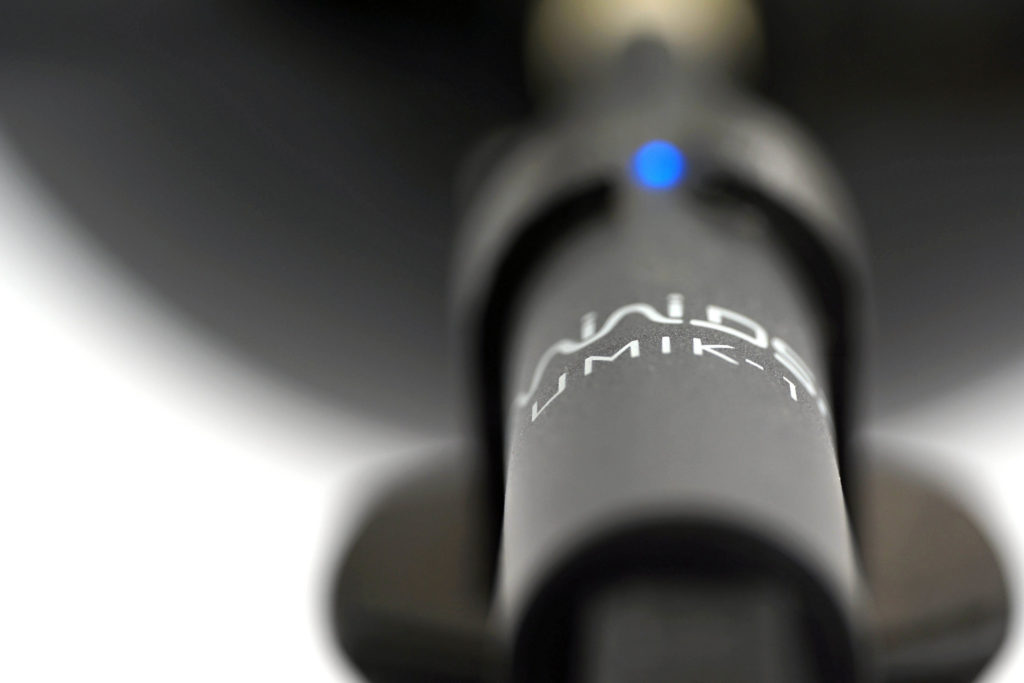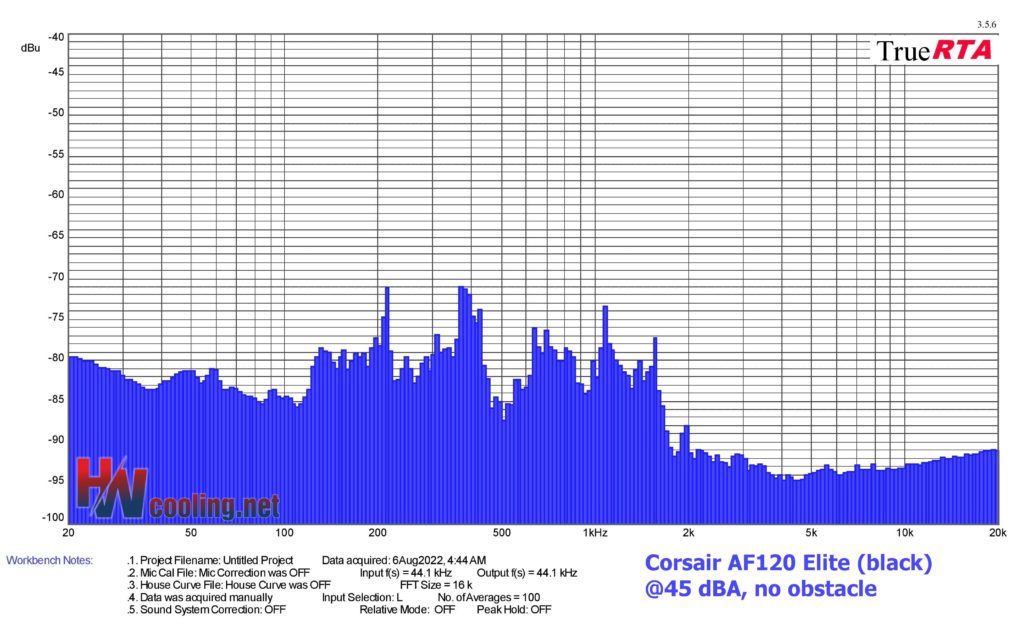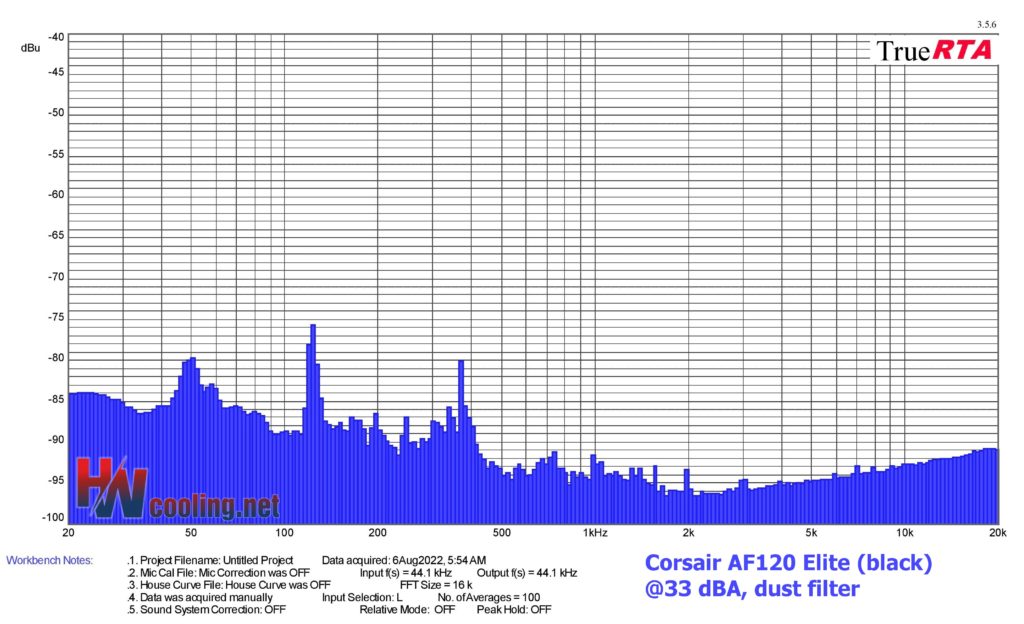Results: Frequency response of sound with a dust filter
You know, the less you expect from something, the bigger the surprise can be in the end. Not that we approach Corsair’s elite fan with any preconceived notions, but for an absolutely top-notch fan, its design seems a bit simple. And that’s the magic of the AF120 Elite fan. Someone who knows what they’re doing was behind its design, because they did a hell of a job.
Results: Frequency response of sound with a dust filter
Measurements are performed in the TrueRTA application, which records sound in a range of 240 frequencies in the recorded range of 20–20,000 Hz. For the possibility of comparison across articles, we export the dominant frequency from the low (20–200 Hz), medium (201–2,000 Hz) and high (2,001–20,000 Hz) range to standard bar graphs.
However, for an even more detailed analysis of the sound expression, it is important to perceive the overall shape of the graph and the intensity of all frequencies/tones. If you don’t understand something in the graphs or tables below, you’ll find the answers to all your questions in this article. It explains how to read the measured data below correctly.
Noise levels in the tables below -85 dBu (but watch out for the negative sign, -70 dBu is louder than -80 dBu) can be ignored. They are in fact extremely weak and always far below the limit of human perception, and are often defined by the “noise” of the measurement string. Therefore, do not take even the dominant frequencies within the treble band that exceed 12 kHz too much into account.
| Fan | Dominant sound freq. and noise level, dust filter@33 dBA | NF-F12 PWM | NF-A15 PWM | ||||
| Low range | Mid range | High range | |||||
| Frequency [Hz] | Noise level [dBu] | Frequency [Hz] | Noise level [dBu] | Frequency [Hz] | Noise level [dBu] | ||
| Gelid Zodiac | 116,5 | -71,5 | 261,4 | -78,3 | 19897,0 | -91,1 | |
| Fractal Design Dynamic X2 GP-12 PWM | 44,9 | -75,1 | 1612,7 | -82,1 | 18780,2 | -90,7 | |
| BeQuiet! Pure Wings 2 (BL039) | 50,4 | -80,1 | 116,5 | -84,2 | 19330,5 | -90,9 | |
| Gigabyte Aorus 120 ARGB | 138,5 | -78,7 | 369,7 | -83,1 | 19330,5 | -90,8 | |
| Arctic BioniX P120 A-RGB | 47,6 | -75,5 | 439,7 | -83,8 | 19330,5 | -91,0 | |
| Akasa OTTO SF12 | N/A | N/A | N/A | N/A | N/A | N/A | |
| Cooler Master SickleFlow 120 ARGB | 59,9 | -86,1 | 1045,7 | -81,6 | 19330,5 | -91,0 | |
| Alphacool SL-15 PWM | 190,3 | -79,4 | 380,5 | -79,1 | 19330,5 | -90,9 | |
| Arctic BioniX F120 | 119,9 | -76,7 | 369,7 | -83,0 | 19897,0 | -90,9 | |
| SilverStone SST-AP123 | SilverStone SST-AP123 | 100,8 | -81,0 | 415,0 | -78,6 | 19330,5 | -90,8 |
| Noctua NF-P12 redux-1700 PWM | 50,4 | -74,5 | 329,4 | -73,7 | 19897,0 | -91,0 | |
| SilentiumPC Fluctus 120 PWM | 119,9 | -79,6 | 380,5 | -80,9 | 19330,5 | -90,7 | |
| MSI MEG Silent Gale P12 | 134,5 | -78,9 | 369,7 | -82,8 | 19330,5 | -90,8 | |
| Asus ROG Strix XF120 | 95,1 | -74,3 | 380,5 | -85,8 | 19330,5 | -91,0 | |
| Akasa Vegas X7 | 116,5 | -77,5 | 369,7 | -85,6 | 19330,5 | -90,7 | |
| Reeven Coldwing 12 | 123,4 | -76,8 | 1566,8 | -92,1 | 19330,5 | -90,7 | |
| Reeven Kiran | 130,7 | -72,9 | 239,7 | -86,9 | 19330,5 | -90,8 | |
| SilentiumPC Sigma Pro 120 PWM | N/A | N/A | N/A | N/A | N/A | N/A | |
| SilentiumPC Sigma Pro Corona RGB 120 | 103,7 | -79,2 | 369,7 | -83,6 | 19330,5 | -90,9 | |
| SilverStone SST-AP121 | 50,4 | -81,8 | 155,4 | -78,6 | 18780,2 | -91,0 | |
| SilverStone SST-FQ121 | 41,8 | -75,8 | 329,4 | -82,7 | 19330,5 | -91,0 | |
| Xigmatek XLF-F1256 | 47,6 | -74,2 | 232,9 | -78,7 | 19897,0 | -91,2 |
| Fan | Dominant sound freq. and noise level, dust filter@39 dBA | NF-F12 PWM | NF-A15 PWM | ||||
| Low range | Mid range | High range | |||||
| Frequency [Hz] | Noise level [dBu] | Frequency [Hz] | Noise level [dBu] | Frequency [Hz] | Noise level [dBu] | ||
| Gelid Zodiac | 146,7 | -66,9 | 261,4 | -78,1 | 2957,7 | -90,1 | |
| Fractal Design Dynamic X2 GP-12 PWM | 127,0 | -78,5 | 1566,8 | -73,8 | 19897,0 | -90,9 | |
| BeQuiet! Pure Wings 2 (BL039) | 130,7 | -79,7 | 427,1 | -75,1 | 19330,5 | -90,9 | |
| Gigabyte Aorus 120 ARGB | 184,9 | -73,7 | 369,7 | -75,5 | 2873,5 | -89,9 | |
| Arctic BioniX P120 A-RGB | 127,0 | -68,2 | 213,6 | -68,8 | 18245,6 | -91,0 | |
| Akasa OTTO SF12 | 155,4 | -68,4 | 391,7 | -76,2 | 4431,5 | -87,9 | |
| Cooler Master SickleFlow 120 ARGB | 123,4 | -73,9 | 1045,7 | -74,0 | 19330,5 | -90,9 | |
| Alphacool SL-15 PWM | 127,0 | -72,9 | 380,5 | -75,1 | 19330,5 | -90,9 | |
| Arctic BioniX F120 | 151,0 | -70,8 | 310,9 | -71,0 | 19330,5 | -90,9 | |
| SilverStone SST-AP123 | SilverStone SST-AP123 | 160,0 | -78,3 | 349,0 | -75,2 | 19897,0 | -91,0 |
| Noctua NF-P12 redux-1700 PWM | 142,5 | -73,2 | 320,0 | -69,0 | 19897,0 | -91,0 | |
| SilentiumPC Fluctus 120 PWM | 130,7 | -79,1 | 359,2 | -75,9 | 2957,7 | -89,3 | |
| MSI MEG Silent Gale P12 | 179,6 | -74,1 | 369,7 | -76,6 | 2957,7 | -89,1 | |
| Asus ROG Strix XF120 | Asus ROG Strix XF120 | 130,7 | -63,8 | 329,4 | -76,4 | 4832,6 | -90,4 |
| Akasa Vegas X7 | 151,0 | -69,1 | 369,7 | -77,7 | 19330,5 | -90,8 | |
| Reeven Coldwing 12 | 155,4 | -66,4 | 369,7 | -77,8 | 18780,2 | -90,9 | |
| Reeven Kiran | 169,5 | -67,8 | 369,7 | -78,0 | 17726,2 | -90,2 | |
| SilentiumPC Sigma Pro 120 PWM | 123,4 | -68,6 | 369,7 | -75,2 | 2873,5 | -86,7 | |
| SilentiumPC Sigma Pro Corona RGB 120 | 138,5 | -68,1 | 391,7 | -78,0 | 2487,1 | -88,9 | |
| SilverStone SST-AP121 | 151,0 | -78,6 | 339,0 | -74,3 | 19897,0 | -90,9 | |
| SilverStone SST-FQ121 | 142,5 | -69,8 | 1173,8 | -74,9 | 2031,9 | -90,2 | |
| Xigmatek XLF-F1256 | 113,1 | -71,2 | 369,7 | -74,8 | 18780,2 | -91,0 |
| Fan | Dominant sound freq. and noise level, dust filter@45 dBA | NF-F12 PWM | NF-A15 PWM | ||||
| Low range | Mid range | High range | |||||
| Frequency [Hz] | Noise level [dBu] | Frequency [Hz] | Noise level [-dBu] | Frequency [Hz] | Noise level [dBu] | ||
| Gelid Zodiac | 184,9 | -61,8 | 380,5 | -68,7 | 18780,2 | -90,8 | |
| Fractal Design Dynamic X2 GP-12 PWM | 138,5 | -72,2 | 320,0 | -62,5 | 3726,5 | -85,3 | |
| BeQuiet! Pure Wings 2 (BL046) | 50,4 | -78,0 | 369,7 | -72,3 | 5747,0 | -80,1 | |
| Gigabyte Aorus 120 ARGB | 127,0 | -75,9 | 226,3 | -67,6 | 5747,0 | -81,238 | |
| Arctic BioniX P120 A-RGB | 130,7 | -70,3 | 339,0 | -75,0 | 5120,0 | -87,8 | |
| Akasa OTTO SF12 | 195,8 | -61,3 | 391,7 | -70,0 | 5747,0 | -83,9 | |
| Cooler Master SickleFlow 120 ARGB | 127,0 | -68,4 | 1015,9 | -66,2 | 4974,2 | -88,7 | |
| Alphacool SL-15 PWM | 77,7 | -77,3 | 403,2 | -69,9 | 4974,2 | -81,9 | |
| Arctic BioniX F120 | 190,3 | -67,4 | 380,5 | -66,5 | 5583,4 | -82,2 | |
| SilverStone SST-AP123 | SilverStone SST-AP123 | 134,5 | -71,2 | 369,7 | -69,2 | 5583,4 | -82,9 |
| Noctua NF-P12 redux-1700 PWM | 184,9 | -69,1 | 320,0 | -65,5 | 5270,0 | -85,1 | |
| SilentiumPC Fluctus 120 PWM | 195,8 | -66,5 | 380,5 | -69,1 | 2957,7 | -83,7 | |
| MSI MEG Silent Gale P12 | 127,0 | -73,0 | 219,8 | -68,8 | 5747,0 | -83,3 | |
| Asus ROG Strix XF120 | Asus ROG Strix XF120 | 23,1 | -62,9 | 369,7 | -71,7 | 5583,4 | -81,4 |
| Akasa Vegas X7 | N/A | N/A | N/A | N/A | N/A | N/A | |
| Reeven Coldwing 12 | 190,3 | -62,7 | 369,7 | -71,9 | 2347,5 | -86,1 | |
| Reeven Kiran | 169,5 | -67,8 | 369,7 | -78,0 | 17726,2 | -90,2 | |
| SilentiumPC Sigma Pro 120 PWM | 20,3 | -64,4 | 246,8 | -70,1 | 2635,0 | -81,8 | |
| SilentiumPC Sigma Pro Corona RGB 120 | 23,1 | -61,2 | 174,5 | -63,9 | 2487,1 | -84,4 | |
| SilverStone SST-AP121 | 20,3 | -67,9 | 439,7 | -67,9 | 4561,4 | -83,3 | |
| SilverStone SST-FQ121 | 179,6 | -64,9 | 369,7 | -71,2 | 5915,4 | -90,3 | |
| Xigmatek XLF-F1256 | 142,5 | -62,7 | 246,8 | -57,8 | 4974,2 | -83,7 |
- Contents
- Corsair AF120 Elite in detail
- The basis of the methodology, the wind tunnel
- Mounting and vibration measurement
- Initial warm-up and speed recording
- Base 7 equal noise levels…
- .. and sound color (frequency characteristic)
- Static pressure measurement…
- … and airflow
- Everything changes with obstacles
- How we measure power draw and motor power
- Measuring the intensity (and power draw) of lighting
- Results: Speed
- Results: Airlow w/o obstacles
- Results: Airflow through a nylon filter
- Results: Airflow through a plastic filter
- Results: Airflow through a hexagonal grille
- Results: Airflow through a thinner radiator
- Results: Airflow through a thicker radiator
- Results: Static pressure w/o obstacles
- Results: Static pressure through a nylon filter
- Results: Static pressure through a plastic filter
- Results: Static pressure through a hexagonal grille
- Results: Static pressure through a thinner radiator
- Results: Static pressure through a thicker radiator
- Results: Static pressure, efficiency by orientation
- Reality vs. specifications
- Results: Frequency response of sound w/o obstacles
- Results: Frequency response of sound with a dust filter
- Results: Frequency response of sound with a hexagonal grille
- Results: Frequency response of sound with a radiator
- Results: Vibration, in total (3D vector length)
- Results: Vibration, X-axis
- Results: Vibration, Y-axis
- Results: Vibration, Z-axis
- Results: Power draw (and motor power)
- Results: Cooling performance per watt, airflow
- Results: Cooling performance per watt, static pressure
- Airflow per euro
- Static pressure per euro
- Results: Lighting – LED luminance and power draw
- Results: LED to motor power draw ratio
- Evaluation













Hi, After your test I decide to buy it to replace the fan on an ArcticCooling Liquid Freezer 280 mm (so I take the AF140 Elite). The aio will be on the right side of a Lian O11 Dynamic mini and in this order from the right to the left : box panel, radiator, fan in aspiration. And I’ll will mesure if a push pull is possible to it too.
TPu make the review thr same fan, but their conclusion is not good as yours on radiator. What did you think about teir test ? https://www.techpowerup.com/review/corsair-af120-elite-fan/
Thanks for your help
Thank you for your comment, very good decision. As far as cooling performance is concerned you will not get significantly better results, but you will definitely avoid resonant frequencies and secondary noise from higher vibration of Arctic fans. The torque undulation is considerably smaller in the Corsair AF1x0 rotors due to the choice of a stronger material.
Please don’t take offense, but I won’t comment on the TPU tests (just, let’s say we have some reservations about their procedures…). You know our conclusions.
Hi,
Thank you for your reply. I’m conforted in my choice. No soucy for TPU.
As always, felicitation for your amazing work.
Have a great day 😉